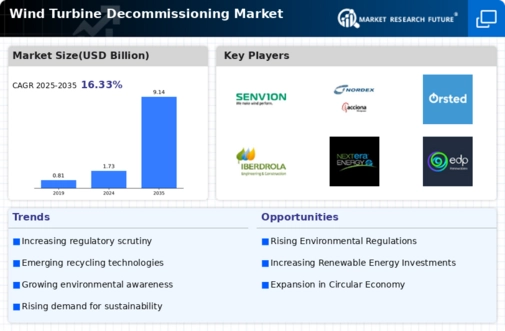Aging Wind Turbine Fleet
The Global Wind Turbine Decommissioning Market Industry is influenced by the aging wind turbine fleet, as many turbines installed in the early 2000s approach the end of their operational lifespan. These aging turbines require decommissioning to ensure safety and efficiency in energy production. As older models are replaced with newer, more efficient technologies, the demand for decommissioning services is likely to increase. This transition not only facilitates the adoption of advanced wind energy solutions but also contributes to the overall growth of the market, which is anticipated to see a substantial rise in activity in the coming years.
Market Growth Projections
The Global Wind Turbine Decommissioning Market Industry is projected to experience substantial growth in the coming years. With the market valued at 1.73 USD Billion in 2024, it is expected to reach 9.14 USD Billion by 2035, indicating a robust compound annual growth rate of 16.34% from 2025 to 2035. This growth trajectory reflects the increasing need for decommissioning services as the global wind energy sector matures. Factors such as aging infrastructure, regulatory requirements, and advancements in technology are likely to drive this expansion, positioning the decommissioning market as a vital component of the renewable energy landscape.
Regulatory Frameworks and Compliance
The Global Wind Turbine Decommissioning Market Industry is shaped by evolving regulatory frameworks that emphasize compliance with environmental standards. Governments are increasingly enacting policies that require wind farm operators to develop comprehensive decommissioning plans, ensuring that the dismantling process adheres to environmental protection guidelines. This regulatory pressure not only promotes responsible decommissioning practices but also creates a structured market for decommissioning services. As compliance becomes a critical factor for wind energy operators, the demand for specialized decommissioning expertise is likely to grow, contributing to the overall expansion of the market.
Growing Need for Sustainable Practices
The Global Wind Turbine Decommissioning Market Industry experiences a growing need for sustainable practices as countries strive to meet environmental targets. Governments worldwide are increasingly implementing regulations that mandate the responsible disposal and recycling of wind turbine components. This trend is particularly evident in regions like Europe, where the European Union has set ambitious goals for carbon neutrality by 2050. As a result, the industry is projected to grow significantly, with the market expected to reach 1.73 USD Billion in 2024 and potentially expand to 9.14 USD Billion by 2035, reflecting a compound annual growth rate of 16.34% from 2025 to 2035.
Increasing Investment in Renewable Energy
The Global Wind Turbine Decommissioning Market Industry is bolstered by increasing investment in renewable energy sources. As nations prioritize clean energy initiatives, the demand for wind energy continues to rise, leading to a larger number of turbines being installed. However, this growth also necessitates the eventual decommissioning of older turbines. The influx of capital into renewable energy projects creates a cycle where decommissioning services become essential for maintaining a sustainable energy landscape. This trend is expected to drive the market forward, as stakeholders recognize the importance of responsible end-of-life management for wind energy assets.
Technological Advancements in Decommissioning
Technological advancements in decommissioning processes are reshaping the Global Wind Turbine Decommissioning Market Industry. Innovations in dismantling techniques, recycling methods, and waste management are enhancing efficiency and reducing costs associated with decommissioning. For instance, the use of specialized equipment and automated systems allows for safer and more effective removal of turbine components. These advancements not only streamline operations but also align with sustainability goals, as they promote the recycling of materials. As the industry embraces these technologies, it is likely to witness increased investment and growth, further solidifying its position in the renewable energy sector.



















Leave a Comment